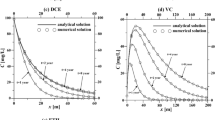Abstract
A steady state version of an analytical solution of the reactive flow and transport problem is derived. This solution allows a better understanding of the steady-state plume characteristics, and allows the prediction of the effectiveness of natural attenuation of sequentially reactive contaminants. The sequential reactions are assumed to be first order. Using spatial moments as compact information of plume characteristics, the total mass, plume centroids, and extents of each contaminant plume are derived as functions of dispersivity, velocity, and reaction rates. The steady-state plume centroids and extents are independent of stoichiometric coefficients. The solution is demonstrated for a four-species sequentially reactive transport in a one-dimensional column. The extension to three dimensions is easily made and does not change the basic functions.
Similar content being viewed by others
References
Bear, J.: 1979, Groundwater Hydraulics, McGraw-Hill, New York.
Beljin, M. S.: 1991, Review of three-dimensional analytical models for solute transport in groundwater system, International groundwater modeling center, Holcomb Research Institute, Butler University, IA.
Borden, R. C. and Bedient, P. B.: 1986, Transport of dissolved hydrocarbon influenced by reaeration and oxygen limited biodegradation: Theoretical development, Water Resour. Res. 22, 1973-1982.
Bosma, W. J. P., van der Zee, S. E. A. T. M. and van Duijn, C. J.: 1996, Plume development of a nonlinearly adsorbing solute in heterogeneous porous formations, Water Resour. Res. 32(6), 1569-1584.
Buscheck, T. E. and Alcantar, C. M.: 1995, Regression techniques and analytical solution to demonstrate intrinsic bioremediation, In: R. E. Hinchee et al. (eds), Intrinsic Bioremediation, Battelle Press, Columbus, OH, pp. 109-116.
Chappelle, F. H., Bradley, P. M., Lovley, D. R. and Vroblesky, D. A.: 1996, Measuring rates of biodegradation in a contaminated aquifer using field and laboratory methods, Ground Water 34(4), 691-698.
Cho, C. M.: 1970, Convective transport of ammonium with nitrification in soil, Can. J. Soil Sci. 51, 339-350.
Clement, T. P., Sun, Y., Hooker, B. S. and Petersen, J. N.: 1998, Modeling multi-species reactive transport in groundwater aquifers, Groundwater Monitoring and Remediation 18(2), 79-92.
Dagan, G.: 1989, Flow and Transport in Porous Formations, Springer-Verlag, New York.
Domenico, P. A.: 1987, An analytical model for multidimensional transport of a decaying contaminant species, J. Hydrol. 91, 49-58.
Lunn, M., Lunn, R. J. and Mackay, R.: 1996, Determining analytic solutions of multiple species contaminant transport with sorption and decay, J. Hydrol. 180, 195-210.
McNab, W. W. Jr. and Dooher, B. P.: 1998, A critique of a steady-state analytical method for estimating contaminant degradation rates, Ground Water 36(6), 983-987.
McNab, W. W. Jr. and Narasimhan, T. N.: 1993, A multiple species transport model with sequential decay chain interactions in heterogeneous subsurface environments, Water Resour. Res. 29(8), 2737-2746.
Molz, F. L., Widdowson, M. A. and Benefield, L. D.: 1986, Simulation of microbial growth dynamics coupled to nutrient oxygen transport in porous media, Water Resour. Res. 22(8), 1207-1216.
Murray, W. D. and Richardson, R.: 1993, Progress toward the biological treatment of C 1 and C 2 halogenated hydrocarbon, Crit. Rev. Environ. Sci. Tech. 23(3), 195-217.
Sun, Y., Petersen, J. N., Clement, T. P. and Skeen, R. S.: 1999, Development of analytical solutions for multi-species transport with serial and parallel reactions, Water Resour. Res. 35(1), 185-190.
van Genuchten, M. Th.: 1985, Convective-dispersive transport of solutes involved in sequential firstorder decay reactions, Comput. Geosci. 11(2), 129-147.
Waddill, D.W. and Widdowson, M. A.: 1998, Three-dimensional model for subsurface transport and biodegradation, J. Environ. Eng. 124(4), 336-344.
Xu, T., Samper, J., Ayora, C., Manzano, M. and Custodio, E.: 1999. Modeling of non-isothermal multi-component reactive transport in field scale porous media flow systems, J. Hydrol. 214, 144-164.
Author information
Authors and Affiliations
Rights and permissions
About this article
Cite this article
Petersen, J.N., Sun, Y. An Analytical Solution Evaluating Steady-State Plumes of Sequentially Reactive Contaminants. Transport in Porous Media 41, 287–303 (2000). https://doi.org/10.1023/A:1006680109002
Issue Date:
DOI: https://doi.org/10.1023/A:1006680109002




